Liang-Jian Deng
A Knowledge-driven Adaptive Collaboration of LLMs for Enhancing Medical Decision-making
Sep 18, 2025

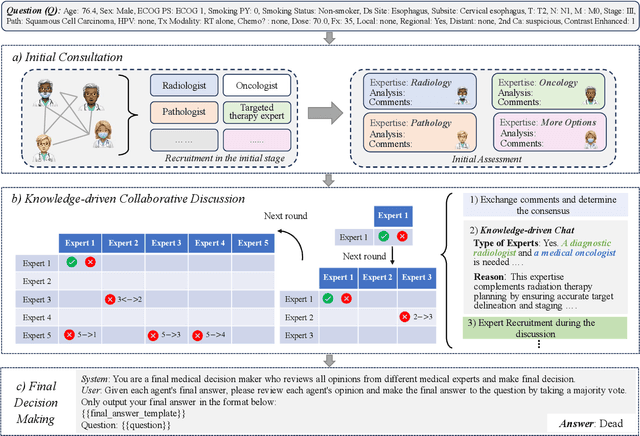

Abstract:Medical decision-making often involves integrating knowledge from multiple clinical specialties, typically achieved through multidisciplinary teams. Inspired by this collaborative process, recent work has leveraged large language models (LLMs) in multi-agent collaboration frameworks to emulate expert teamwork. While these approaches improve reasoning through agent interaction, they are limited by static, pre-assigned roles, which hinder adaptability and dynamic knowledge integration. To address these limitations, we propose KAMAC, a Knowledge-driven Adaptive Multi-Agent Collaboration framework that enables LLM agents to dynamically form and expand expert teams based on the evolving diagnostic context. KAMAC begins with one or more expert agents and then conducts a knowledge-driven discussion to identify and fill knowledge gaps by recruiting additional specialists as needed. This supports flexible, scalable collaboration in complex clinical scenarios, with decisions finalized through reviewing updated agent comments. Experiments on two real-world medical benchmarks demonstrate that KAMAC significantly outperforms both single-agent and advanced multi-agent methods, particularly in complex clinical scenarios (i.e., cancer prognosis) requiring dynamic, cross-specialty expertise. Our code is publicly available at: https://github.com/XiaoXiao-Woo/KAMAC.
Training and Inference within 1 Second -- Tackle Cross-Sensor Degradation of Real-World Pansharpening with Efficient Residual Feature Tailoring
Aug 10, 2025Abstract:Deep learning methods for pansharpening have advanced rapidly, yet models pretrained on data from a specific sensor often generalize poorly to data from other sensors. Existing methods to tackle such cross-sensor degradation include retraining model or zero-shot methods, but they are highly time-consuming or even need extra training data. To address these challenges, our method first performs modular decomposition on deep learning-based pansharpening models, revealing a general yet critical interface where high-dimensional fused features begin mapping to the channel space of the final image. % may need revisement A Feature Tailor is then integrated at this interface to address cross-sensor degradation at the feature level, and is trained efficiently with physics-aware unsupervised losses. Moreover, our method operates in a patch-wise manner, training on partial patches and performing parallel inference on all patches to boost efficiency. Our method offers two key advantages: (1) $\textit{Improved Generalization Ability}$: it significantly enhance performance in cross-sensor cases. (2) $\textit{Low Generalization Cost}$: it achieves sub-second training and inference, requiring only partial test inputs and no external data, whereas prior methods often take minutes or even hours. Experiments on the real-world data from multiple datasets demonstrate that our method achieves state-of-the-art quality and efficiency in tackling cross-sensor degradation. For example, training and inference of $512\times512\times8$ image within $\textit{0.2 seconds}$ and $4000\times4000\times8$ image within $\textit{3 seconds}$ at the fastest setting on a commonly used RTX 3090 GPU, which is over 100 times faster than zero-shot methods.
SWIFT: A General Sensitive Weight Identification Framework for Fast Sensor-Transfer Pansharpening
Jul 27, 2025Abstract:Pansharpening aims to fuse high-resolution panchromatic (PAN) images with low-resolution multispectral (LRMS) images to generate high-resolution multispectral (HRMS) images. Although deep learning-based methods have achieved promising performance, they generally suffer from severe performance degradation when applied to data from unseen sensors. Adapting these models through full-scale retraining or designing more complex architectures is often prohibitively expensive and impractical for real-world deployment. To address this critical challenge, we propose a fast and general-purpose framework for cross-sensor adaptation, SWIFT (Sensitive Weight Identification for Fast Transfer). Specifically, SWIFT employs an unsupervised sampling strategy based on data manifold structures to balance sample selection while mitigating the bias of traditional Farthest Point Sampling, efficiently selecting only 3\% of the most informative samples from the target domain. This subset is then used to probe a source-domain pre-trained model by analyzing the gradient behavior of its parameters, allowing for the quick identification and subsequent update of only the weight subset most sensitive to the domain shift. As a plug-and-play framework, SWIFT can be applied to various existing pansharpening models. Extensive experiments demonstrate that SWIFT reduces the adaptation time from hours to approximately one minute on a single NVIDIA RTX 4090 GPU. The adapted models not only substantially outperform direct-transfer baselines but also achieve performance competitive with, and in some cases superior to, full retraining, establishing a new state-of-the-art on cross-sensor pansharpening tasks for the WorldView-2 and QuickBird datasets.
CAT: A Conditional Adaptation Tailor for Efficient and Effective Instance-Specific Pansharpening on Real-World Data
Apr 14, 2025Abstract:Pansharpening is a crucial remote sensing technique that fuses low-resolution multispectral (LRMS) images with high-resolution panchromatic (PAN) images to generate high-resolution multispectral (HRMS) imagery. Although deep learning techniques have significantly advanced pansharpening, many existing methods suffer from limited cross-sensor generalization and high computational overhead, restricting their real-time applications. To address these challenges, we propose an efficient framework that quickly adapts to a specific input instance, completing both training and inference in a short time. Our framework splits the input image into multiple patches, selects a subset for unsupervised CAT training, and then performs inference on all patches, stitching them into the final output. The CAT module, integrated between the feature extraction and channel transformation stages of a pre-trained network, tailors the fused features and fixes the parameters for efficient inference, generating improved results. Our approach offers two key advantages: (1) $\textit{Improved Generalization Ability}$: by mitigating cross-sensor degradation, our model--although pre-trained on a specific dataset--achieves superior performance on datasets captured by other sensors; (2) $\textit{Enhanced Computational Efficiency}$: the CAT-enhanced network can swiftly adapt to the test sample using the single LRMS-PAN pair input, without requiring extensive large-scale data retraining. Experiments on the real-world data from WorldView-3 and WorldView-2 datasets demonstrate that our method achieves state-of-the-art performance on cross-sensor real-world data, while achieving both training and inference of $512\times512$ image within $\textit{0.4 seconds}$ and $4000\times4000$ image within $\textit{3 seconds}$ at the fastest setting on a commonly used RTX 3090 GPU.
MMAIF: Multi-task and Multi-degradation All-in-One for Image Fusion with Language Guidance
Mar 19, 2025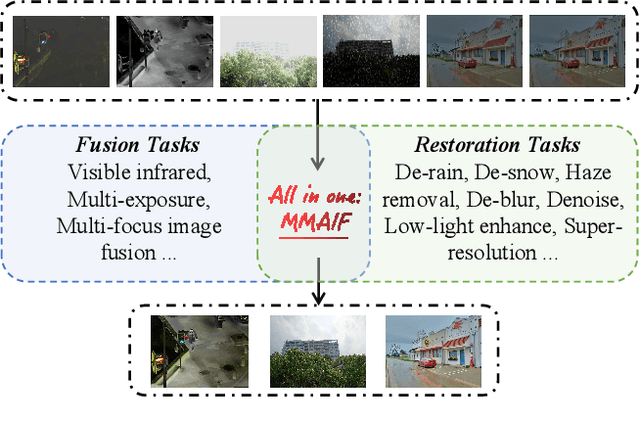


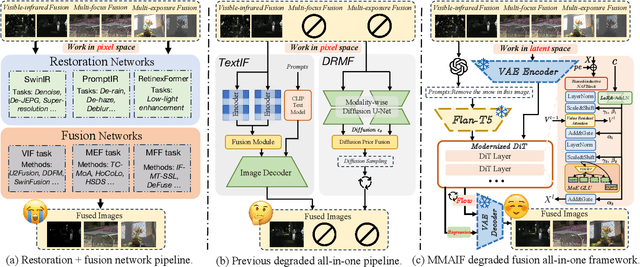
Abstract:Image fusion, a fundamental low-level vision task, aims to integrate multiple image sequences into a single output while preserving as much information as possible from the input. However, existing methods face several significant limitations: 1) requiring task- or dataset-specific models; 2) neglecting real-world image degradations (\textit{e.g.}, noise), which causes failure when processing degraded inputs; 3) operating in pixel space, where attention mechanisms are computationally expensive; and 4) lacking user interaction capabilities. To address these challenges, we propose a unified framework for multi-task, multi-degradation, and language-guided image fusion. Our framework includes two key components: 1) a practical degradation pipeline that simulates real-world image degradations and generates interactive prompts to guide the model; 2) an all-in-one Diffusion Transformer (DiT) operating in latent space, which fuses a clean image conditioned on both the degraded inputs and the generated prompts. Furthermore, we introduce principled modifications to the original DiT architecture to better suit the fusion task. Based on this framework, we develop two versions of the model: Regression-based and Flow Matching-based variants. Extensive qualitative and quantitative experiments demonstrate that our approach effectively addresses the aforementioned limitations and outperforms previous restoration+fusion and all-in-one pipelines. Codes are available at https://github.com/294coder/MMAIF.
Taming Flow Matching with Unbalanced Optimal Transport into Fast Pansharpening
Mar 19, 2025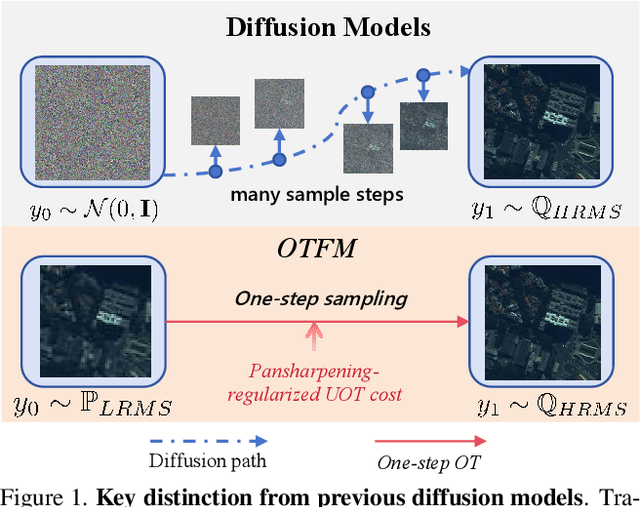
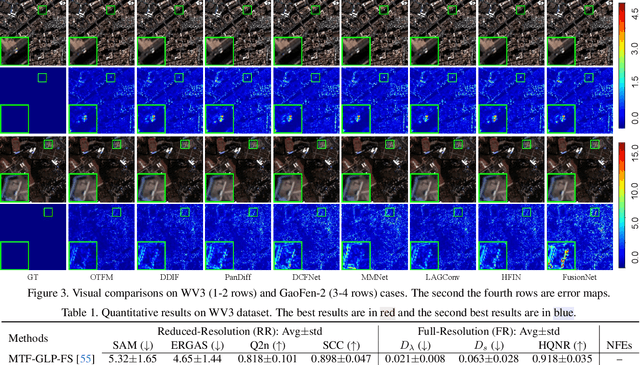
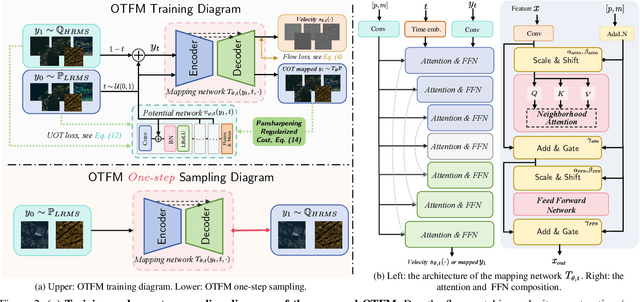
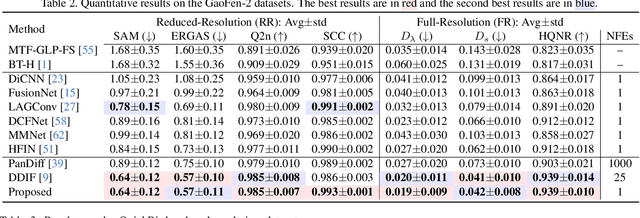
Abstract:Pansharpening, a pivotal task in remote sensing for fusing high-resolution panchromatic and multispectral imagery, has garnered significant research interest. Recent advancements employing diffusion models based on stochastic differential equations (SDEs) have demonstrated state-of-the-art performance. However, the inherent multi-step sampling process of SDEs imposes substantial computational overhead, hindering practical deployment. While existing methods adopt efficient samplers, knowledge distillation, or retraining to reduce sampling steps (e.g., from 1,000 to fewer steps), such approaches often compromise fusion quality. In this work, we propose the Optimal Transport Flow Matching (OTFM) framework, which integrates the dual formulation of unbalanced optimal transport (UOT) to achieve one-step, high-quality pansharpening. Unlike conventional OT formulations that enforce rigid distribution alignment, UOT relaxes marginal constraints to enhance modeling flexibility, accommodating the intrinsic spectral and spatial disparities in remote sensing data. Furthermore, we incorporate task-specific regularization into the UOT objective, enhancing the robustness of the flow model. The OTFM framework enables simulation-free training and single-step inference while maintaining strict adherence to pansharpening constraints. Experimental evaluations across multiple datasets demonstrate that OTFM matches or exceeds the performance of previous regression-based models and leading diffusion-based methods while only needing one sampling step. Codes are available at https://github.com/294coder/PAN-OTFM.
Exploring the Low-Pass Filtering Behavior in Image Super-Resolution
May 17, 2024



Abstract:Deep neural networks for image super-resolution (ISR) have shown significant advantages over traditional approaches like the interpolation. However, they are often criticized as 'black boxes' compared to traditional approaches with solid mathematical foundations. In this paper, we attempt to interpret the behavior of deep neural networks in ISR using theories from the field of signal processing. First, we report an intriguing phenomenon, referred to as `the sinc phenomenon.' It occurs when an impulse input is fed to a neural network. Then, building on this observation, we propose a method named Hybrid Response Analysis (HyRA) to analyze the behavior of neural networks in ISR tasks. Specifically, HyRA decomposes a neural network into a parallel connection of a linear system and a non-linear system and demonstrates that the linear system functions as a low-pass filter while the non-linear system injects high-frequency information. Finally, to quantify the injected high-frequency information, we introduce a metric for image-to-image tasks called Frequency Spectrum Distribution Similarity (FSDS). FSDS reflects the distribution similarity of different frequency components and can capture nuances that traditional metrics may overlook. Code, videos and raw experimental results for this paper can be found in: https://github.com/RisingEntropy/LPFInISR.
Fourier-enhanced Implicit Neural Fusion Network for Multispectral and Hyperspectral Image Fusion
Apr 23, 2024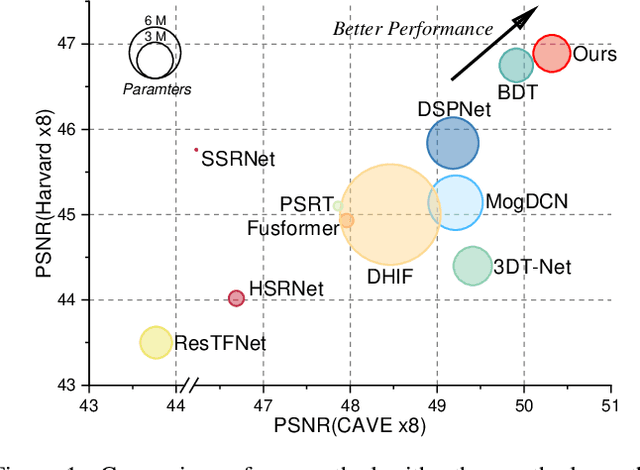
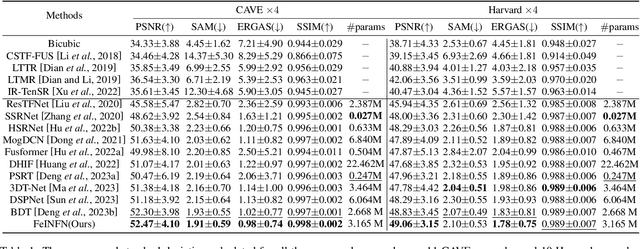
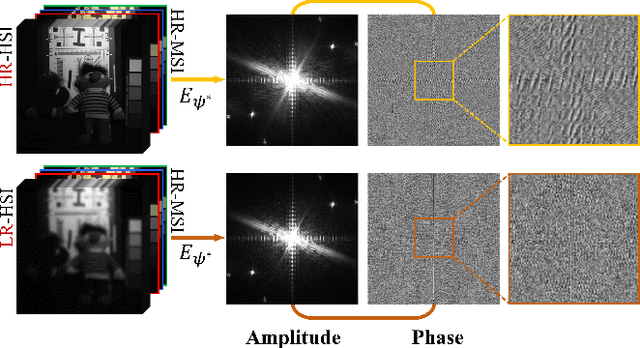

Abstract:Recently, implicit neural representations (INR) have made significant strides in various vision-related domains, providing a novel solution for Multispectral and Hyperspectral Image Fusion (MHIF) tasks. However, INR is prone to losing high-frequency information and is confined to the lack of global perceptual capabilities. To address these issues, this paper introduces a Fourier-enhanced Implicit Neural Fusion Network (FeINFN) specifically designed for MHIF task, targeting the following phenomena: The Fourier amplitudes of the HR-HSI latent code and LR-HSI are remarkably similar; however, their phases exhibit different patterns. In FeINFN, we innovatively propose a spatial and frequency implicit fusion function (Spa-Fre IFF), helping INR capture high-frequency information and expanding the receptive field. Besides, a new decoder employing a complex Gabor wavelet activation function, called Spatial-Frequency Interactive Decoder (SFID), is invented to enhance the interaction of INR features. Especially, we further theoretically prove that the Gabor wavelet activation possesses a time-frequency tightness property that favors learning the optimal bandwidths in the decoder. Experiments on two benchmark MHIF datasets verify the state-of-the-art (SOTA) performance of the proposed method, both visually and quantitatively. Also, ablation studies demonstrate the mentioned contributions. The code will be available on Anonymous GitHub (https://anonymous.4open.science/r/FeINFN-15C9/) after possible acceptance.
Neural Shrödinger Bridge Matching for Pansharpening
Apr 17, 2024Abstract:Recent diffusion probabilistic models (DPM) in the field of pansharpening have been gradually gaining attention and have achieved state-of-the-art (SOTA) performance. In this paper, we identify shortcomings in directly applying DPMs to the task of pansharpening as an inverse problem: 1) initiating sampling directly from Gaussian noise neglects the low-resolution multispectral image (LRMS) as a prior; 2) low sampling efficiency often necessitates a higher number of sampling steps. We first reformulate pansharpening into the stochastic differential equation (SDE) form of an inverse problem. Building upon this, we propose a Schr\"odinger bridge matching method that addresses both issues. We design an efficient deep neural network architecture tailored for the proposed SB matching. In comparison to the well-established DL-regressive-based framework and the recent DPM framework, our method demonstrates SOTA performance with fewer sampling steps. Moreover, we discuss the relationship between SB matching and other methods based on SDEs and ordinary differential equations (ODEs), as well as its connection with optimal transport. Code will be available.
SSDiff: Spatial-spectral Integrated Diffusion Model for Remote Sensing Pansharpening
Apr 17, 2024



Abstract:Pansharpening is a significant image fusion technique that merges the spatial content and spectral characteristics of remote sensing images to generate high-resolution multispectral images. Recently, denoising diffusion probabilistic models have been gradually applied to visual tasks, enhancing controllable image generation through low-rank adaptation (LoRA). In this paper, we introduce a spatial-spectral integrated diffusion model for the remote sensing pansharpening task, called SSDiff, which considers the pansharpening process as the fusion process of spatial and spectral components from the perspective of subspace decomposition. Specifically, SSDiff utilizes spatial and spectral branches to learn spatial details and spectral features separately, then employs a designed alternating projection fusion module (APFM) to accomplish the fusion. Furthermore, we propose a frequency modulation inter-branch module (FMIM) to modulate the frequency distribution between branches. The two components of SSDiff can perform favorably against the APFM when utilizing a LoRA-like branch-wise alternative fine-tuning method. It refines SSDiff to capture component-discriminating features more sufficiently. Finally, extensive experiments on four commonly used datasets, i.e., WorldView-3, WorldView-2, GaoFen-2, and QuickBird, demonstrate the superiority of SSDiff both visually and quantitatively. The code will be made open source after possible acceptance.
 Add to Chrome
Add to Chrome Add to Firefox
Add to Firefox Add to Edge
Add to Edge